Temple & Webster: Business Communication Assessment Report Analysis
VerifiedAdded on 2021/12/14
|9
|2594
|27
Report
AI Summary
This report provides a detailed analysis of Temple & Webster's business communication strategies. It begins with an overview of the company and its current communication processes, including face-to-face interactions, electronic mediums like email and intranet, written messages, and broadcast media. The report then identifies the strengths of these existing systems, such as the effectiveness of face-to-face communication and the efficiency of electronic mediums. However, it also highlights gaps, such as the time lag in email communication and the lack of contextual cues in written messages. To address these gaps, the report proposes the implementation of a digital communication strategy centered around instant messaging. The benefits and scope of this strategy are discussed, including enhanced communication, improved efficacy, and presence awareness. Finally, the report recommends a detailed implementation process, including platform selection, security considerations, collaboration features, employee education, and expectation management.
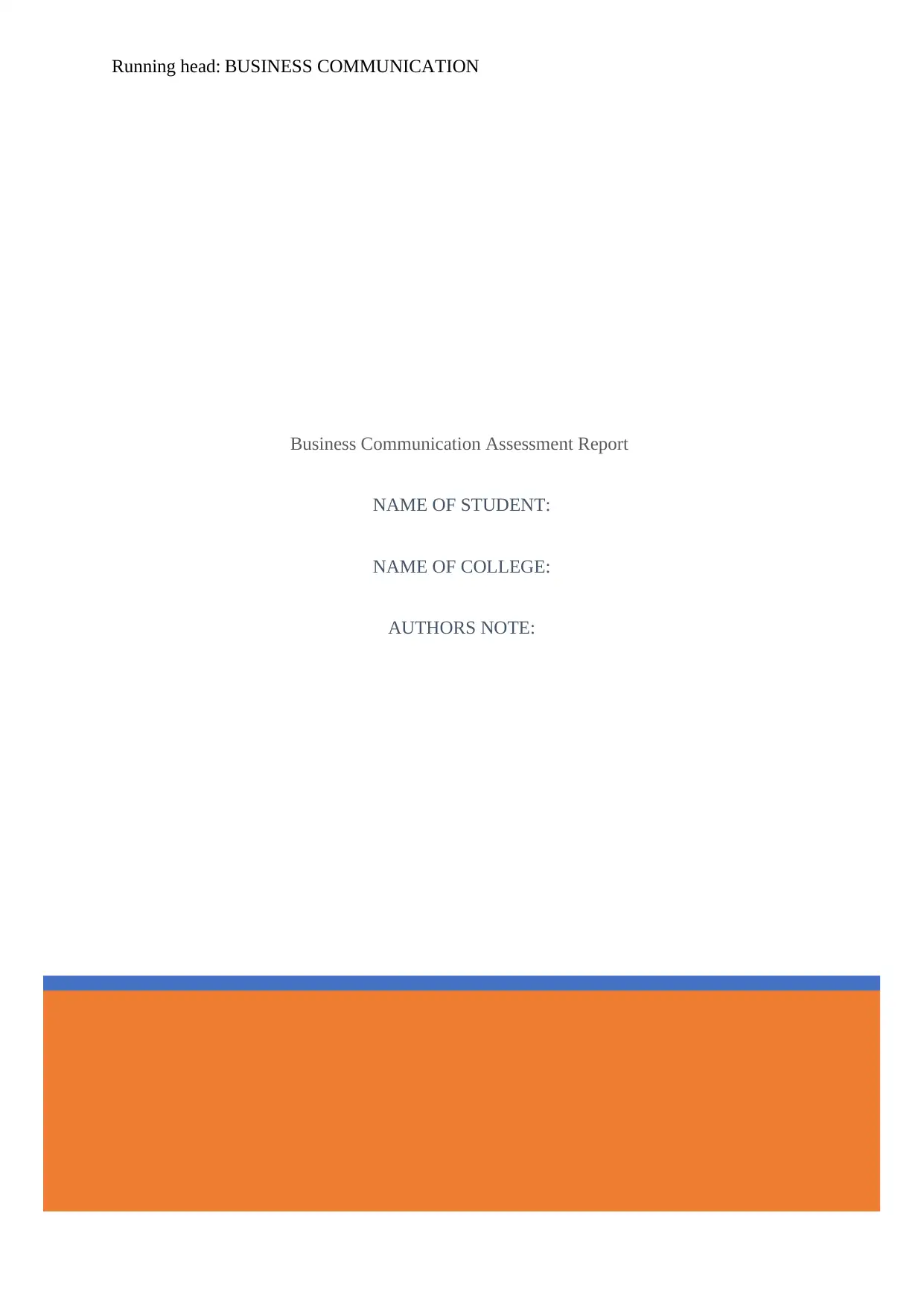
Business Communication Assessment Report
NAME OF STUDENT:
NAME OF COLLEGE:
AUTHORS NOTE:
Running head: BUSINESS COMMUNICATION
NAME OF STUDENT:
NAME OF COLLEGE:
AUTHORS NOTE:
Running head: BUSINESS COMMUNICATION
Paraphrase This Document
Need a fresh take? Get an instant paraphrase of this document with our AI Paraphraser
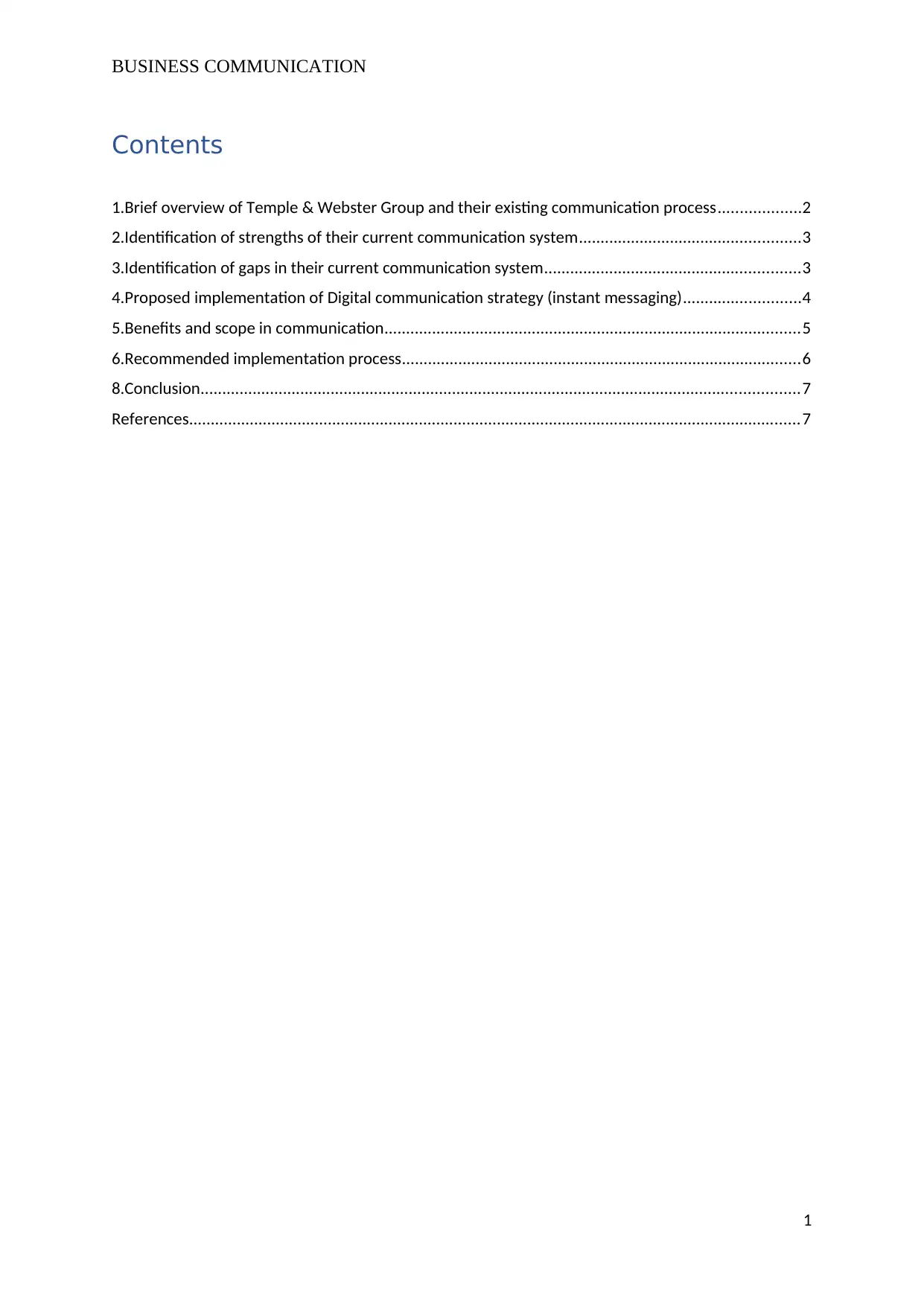
BUSINESS COMMUNICATION
Contents
1.Brief overview of Temple & Webster Group and their existing communication process...................2
2.Identification of strengths of their current communication system...................................................3
3.Identification of gaps in their current communication system...........................................................3
4.Proposed implementation of Digital communication strategy (instant messaging)...........................4
5.Benefits and scope in communication................................................................................................5
6.Recommended implementation process............................................................................................6
8.Conclusion..........................................................................................................................................7
References.............................................................................................................................................7
1
Contents
1.Brief overview of Temple & Webster Group and their existing communication process...................2
2.Identification of strengths of their current communication system...................................................3
3.Identification of gaps in their current communication system...........................................................3
4.Proposed implementation of Digital communication strategy (instant messaging)...........................4
5.Benefits and scope in communication................................................................................................5
6.Recommended implementation process............................................................................................6
8.Conclusion..........................................................................................................................................7
References.............................................................................................................................................7
1
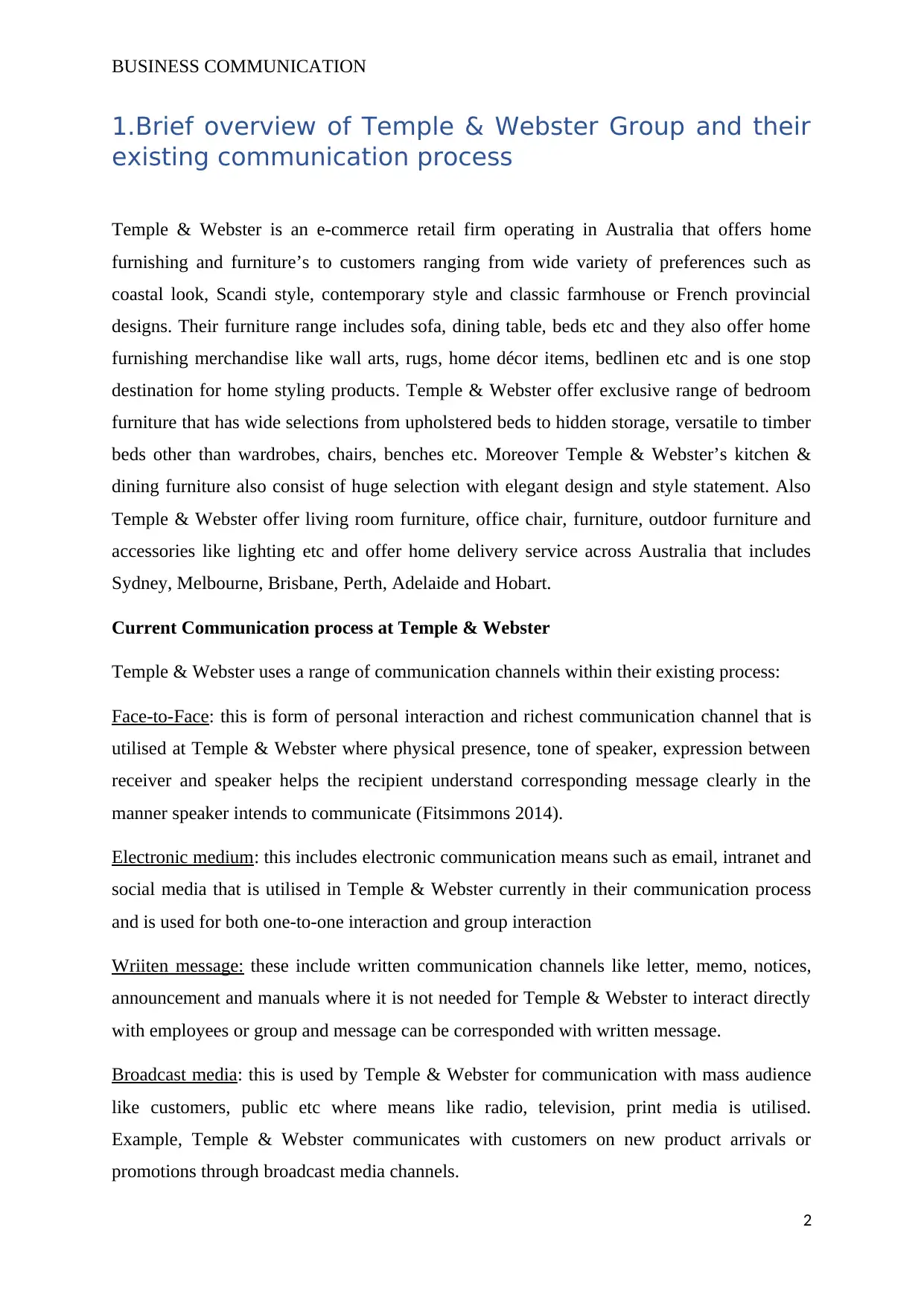
BUSINESS COMMUNICATION
1.Brief overview of Temple & Webster Group and their
existing communication process
Temple & Webster is an e-commerce retail firm operating in Australia that offers home
furnishing and furniture’s to customers ranging from wide variety of preferences such as
coastal look, Scandi style, contemporary style and classic farmhouse or French provincial
designs. Their furniture range includes sofa, dining table, beds etc and they also offer home
furnishing merchandise like wall arts, rugs, home décor items, bedlinen etc and is one stop
destination for home styling products. Temple & Webster offer exclusive range of bedroom
furniture that has wide selections from upholstered beds to hidden storage, versatile to timber
beds other than wardrobes, chairs, benches etc. Moreover Temple & Webster’s kitchen &
dining furniture also consist of huge selection with elegant design and style statement. Also
Temple & Webster offer living room furniture, office chair, furniture, outdoor furniture and
accessories like lighting etc and offer home delivery service across Australia that includes
Sydney, Melbourne, Brisbane, Perth, Adelaide and Hobart.
Current Communication process at Temple & Webster
Temple & Webster uses a range of communication channels within their existing process:
Face-to-Face: this is form of personal interaction and richest communication channel that is
utilised at Temple & Webster where physical presence, tone of speaker, expression between
receiver and speaker helps the recipient understand corresponding message clearly in the
manner speaker intends to communicate (Fitsimmons 2014).
Electronic medium: this includes electronic communication means such as email, intranet and
social media that is utilised in Temple & Webster currently in their communication process
and is used for both one-to-one interaction and group interaction
Wriiten message: these include written communication channels like letter, memo, notices,
announcement and manuals where it is not needed for Temple & Webster to interact directly
with employees or group and message can be corresponded with written message.
Broadcast media: this is used by Temple & Webster for communication with mass audience
like customers, public etc where means like radio, television, print media is utilised.
Example, Temple & Webster communicates with customers on new product arrivals or
promotions through broadcast media channels.
2
1.Brief overview of Temple & Webster Group and their
existing communication process
Temple & Webster is an e-commerce retail firm operating in Australia that offers home
furnishing and furniture’s to customers ranging from wide variety of preferences such as
coastal look, Scandi style, contemporary style and classic farmhouse or French provincial
designs. Their furniture range includes sofa, dining table, beds etc and they also offer home
furnishing merchandise like wall arts, rugs, home décor items, bedlinen etc and is one stop
destination for home styling products. Temple & Webster offer exclusive range of bedroom
furniture that has wide selections from upholstered beds to hidden storage, versatile to timber
beds other than wardrobes, chairs, benches etc. Moreover Temple & Webster’s kitchen &
dining furniture also consist of huge selection with elegant design and style statement. Also
Temple & Webster offer living room furniture, office chair, furniture, outdoor furniture and
accessories like lighting etc and offer home delivery service across Australia that includes
Sydney, Melbourne, Brisbane, Perth, Adelaide and Hobart.
Current Communication process at Temple & Webster
Temple & Webster uses a range of communication channels within their existing process:
Face-to-Face: this is form of personal interaction and richest communication channel that is
utilised at Temple & Webster where physical presence, tone of speaker, expression between
receiver and speaker helps the recipient understand corresponding message clearly in the
manner speaker intends to communicate (Fitsimmons 2014).
Electronic medium: this includes electronic communication means such as email, intranet and
social media that is utilised in Temple & Webster currently in their communication process
and is used for both one-to-one interaction and group interaction
Wriiten message: these include written communication channels like letter, memo, notices,
announcement and manuals where it is not needed for Temple & Webster to interact directly
with employees or group and message can be corresponded with written message.
Broadcast media: this is used by Temple & Webster for communication with mass audience
like customers, public etc where means like radio, television, print media is utilised.
Example, Temple & Webster communicates with customers on new product arrivals or
promotions through broadcast media channels.
2
⊘ This is a preview!⊘
Do you want full access?
Subscribe today to unlock all pages.

Trusted by 1+ million students worldwide
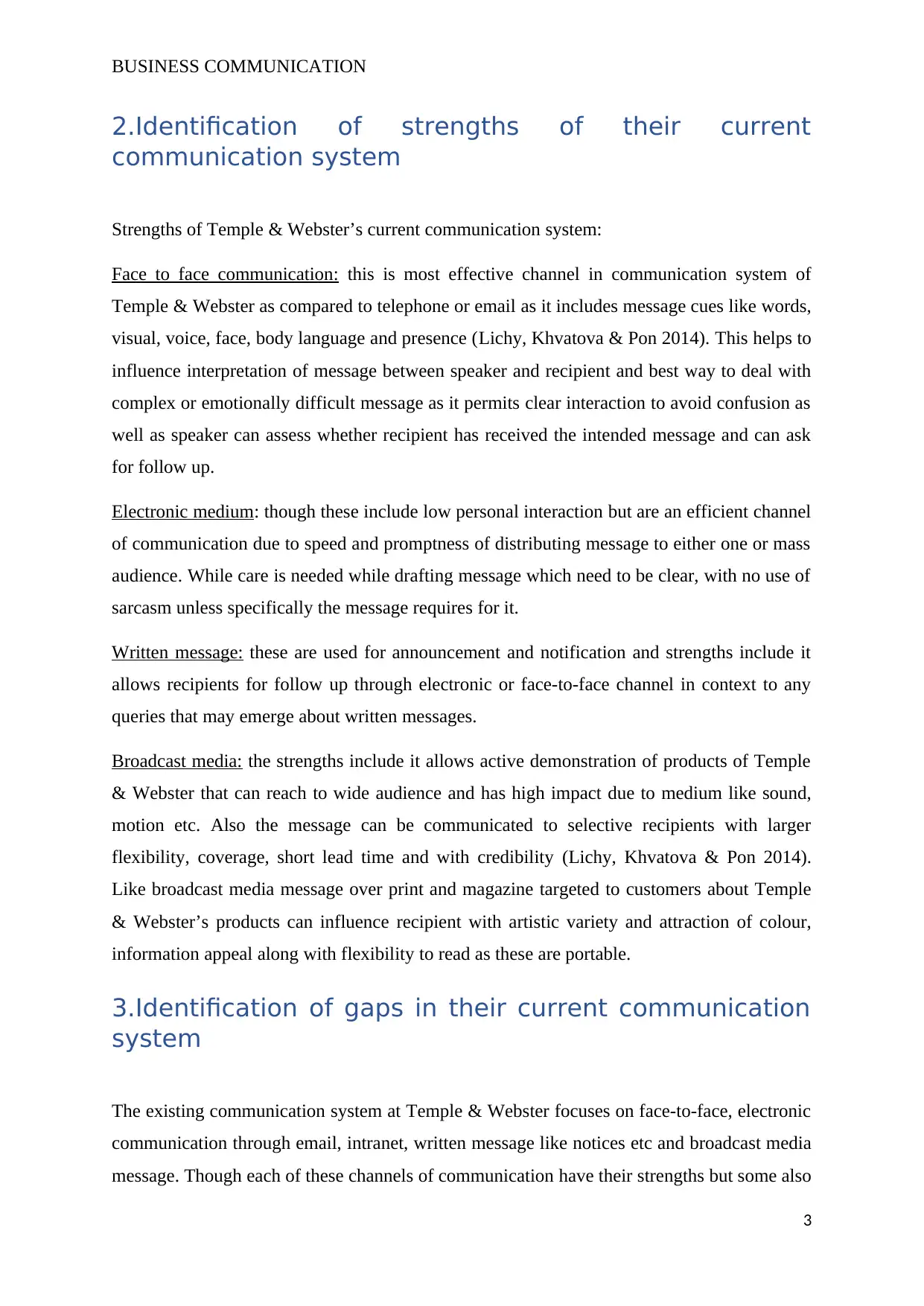
BUSINESS COMMUNICATION
2.Identification of strengths of their current
communication system
Strengths of Temple & Webster’s current communication system:
Face to face communication: this is most effective channel in communication system of
Temple & Webster as compared to telephone or email as it includes message cues like words,
visual, voice, face, body language and presence (Lichy, Khvatova & Pon 2014). This helps to
influence interpretation of message between speaker and recipient and best way to deal with
complex or emotionally difficult message as it permits clear interaction to avoid confusion as
well as speaker can assess whether recipient has received the intended message and can ask
for follow up.
Electronic medium: though these include low personal interaction but are an efficient channel
of communication due to speed and promptness of distributing message to either one or mass
audience. While care is needed while drafting message which need to be clear, with no use of
sarcasm unless specifically the message requires for it.
Written message: these are used for announcement and notification and strengths include it
allows recipients for follow up through electronic or face-to-face channel in context to any
queries that may emerge about written messages.
Broadcast media: the strengths include it allows active demonstration of products of Temple
& Webster that can reach to wide audience and has high impact due to medium like sound,
motion etc. Also the message can be communicated to selective recipients with larger
flexibility, coverage, short lead time and with credibility (Lichy, Khvatova & Pon 2014).
Like broadcast media message over print and magazine targeted to customers about Temple
& Webster’s products can influence recipient with artistic variety and attraction of colour,
information appeal along with flexibility to read as these are portable.
3.Identification of gaps in their current communication
system
The existing communication system at Temple & Webster focuses on face-to-face, electronic
communication through email, intranet, written message like notices etc and broadcast media
message. Though each of these channels of communication have their strengths but some also
3
2.Identification of strengths of their current
communication system
Strengths of Temple & Webster’s current communication system:
Face to face communication: this is most effective channel in communication system of
Temple & Webster as compared to telephone or email as it includes message cues like words,
visual, voice, face, body language and presence (Lichy, Khvatova & Pon 2014). This helps to
influence interpretation of message between speaker and recipient and best way to deal with
complex or emotionally difficult message as it permits clear interaction to avoid confusion as
well as speaker can assess whether recipient has received the intended message and can ask
for follow up.
Electronic medium: though these include low personal interaction but are an efficient channel
of communication due to speed and promptness of distributing message to either one or mass
audience. While care is needed while drafting message which need to be clear, with no use of
sarcasm unless specifically the message requires for it.
Written message: these are used for announcement and notification and strengths include it
allows recipients for follow up through electronic or face-to-face channel in context to any
queries that may emerge about written messages.
Broadcast media: the strengths include it allows active demonstration of products of Temple
& Webster that can reach to wide audience and has high impact due to medium like sound,
motion etc. Also the message can be communicated to selective recipients with larger
flexibility, coverage, short lead time and with credibility (Lichy, Khvatova & Pon 2014).
Like broadcast media message over print and magazine targeted to customers about Temple
& Webster’s products can influence recipient with artistic variety and attraction of colour,
information appeal along with flexibility to read as these are portable.
3.Identification of gaps in their current communication
system
The existing communication system at Temple & Webster focuses on face-to-face, electronic
communication through email, intranet, written message like notices etc and broadcast media
message. Though each of these channels of communication have their strengths but some also
3
Paraphrase This Document
Need a fresh take? Get an instant paraphrase of this document with our AI Paraphraser
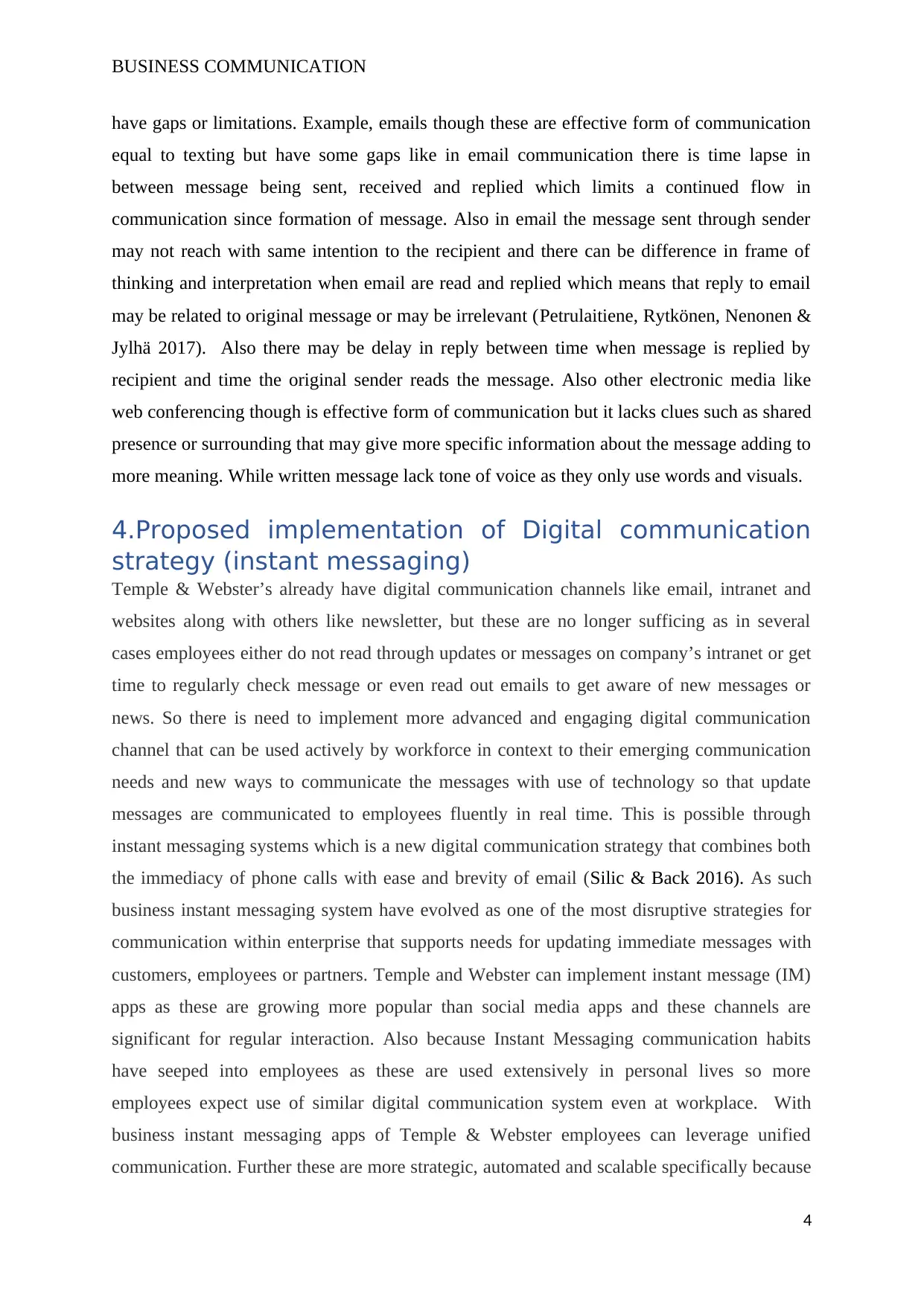
BUSINESS COMMUNICATION
have gaps or limitations. Example, emails though these are effective form of communication
equal to texting but have some gaps like in email communication there is time lapse in
between message being sent, received and replied which limits a continued flow in
communication since formation of message. Also in email the message sent through sender
may not reach with same intention to the recipient and there can be difference in frame of
thinking and interpretation when email are read and replied which means that reply to email
may be related to original message or may be irrelevant (Petrulaitiene, Rytkönen, Nenonen &
Jylhä 2017). Also there may be delay in reply between time when message is replied by
recipient and time the original sender reads the message. Also other electronic media like
web conferencing though is effective form of communication but it lacks clues such as shared
presence or surrounding that may give more specific information about the message adding to
more meaning. While written message lack tone of voice as they only use words and visuals.
4.Proposed implementation of Digital communication
strategy (instant messaging)
Temple & Webster’s already have digital communication channels like email, intranet and
websites along with others like newsletter, but these are no longer sufficing as in several
cases employees either do not read through updates or messages on company’s intranet or get
time to regularly check message or even read out emails to get aware of new messages or
news. So there is need to implement more advanced and engaging digital communication
channel that can be used actively by workforce in context to their emerging communication
needs and new ways to communicate the messages with use of technology so that update
messages are communicated to employees fluently in real time. This is possible through
instant messaging systems which is a new digital communication strategy that combines both
the immediacy of phone calls with ease and brevity of email (Silic & Back 2016). As such
business instant messaging system have evolved as one of the most disruptive strategies for
communication within enterprise that supports needs for updating immediate messages with
customers, employees or partners. Temple and Webster can implement instant message (IM)
apps as these are growing more popular than social media apps and these channels are
significant for regular interaction. Also because Instant Messaging communication habits
have seeped into employees as these are used extensively in personal lives so more
employees expect use of similar digital communication system even at workplace. With
business instant messaging apps of Temple & Webster employees can leverage unified
communication. Further these are more strategic, automated and scalable specifically because
4
have gaps or limitations. Example, emails though these are effective form of communication
equal to texting but have some gaps like in email communication there is time lapse in
between message being sent, received and replied which limits a continued flow in
communication since formation of message. Also in email the message sent through sender
may not reach with same intention to the recipient and there can be difference in frame of
thinking and interpretation when email are read and replied which means that reply to email
may be related to original message or may be irrelevant (Petrulaitiene, Rytkönen, Nenonen &
Jylhä 2017). Also there may be delay in reply between time when message is replied by
recipient and time the original sender reads the message. Also other electronic media like
web conferencing though is effective form of communication but it lacks clues such as shared
presence or surrounding that may give more specific information about the message adding to
more meaning. While written message lack tone of voice as they only use words and visuals.
4.Proposed implementation of Digital communication
strategy (instant messaging)
Temple & Webster’s already have digital communication channels like email, intranet and
websites along with others like newsletter, but these are no longer sufficing as in several
cases employees either do not read through updates or messages on company’s intranet or get
time to regularly check message or even read out emails to get aware of new messages or
news. So there is need to implement more advanced and engaging digital communication
channel that can be used actively by workforce in context to their emerging communication
needs and new ways to communicate the messages with use of technology so that update
messages are communicated to employees fluently in real time. This is possible through
instant messaging systems which is a new digital communication strategy that combines both
the immediacy of phone calls with ease and brevity of email (Silic & Back 2016). As such
business instant messaging system have evolved as one of the most disruptive strategies for
communication within enterprise that supports needs for updating immediate messages with
customers, employees or partners. Temple and Webster can implement instant message (IM)
apps as these are growing more popular than social media apps and these channels are
significant for regular interaction. Also because Instant Messaging communication habits
have seeped into employees as these are used extensively in personal lives so more
employees expect use of similar digital communication system even at workplace. With
business instant messaging apps of Temple & Webster employees can leverage unified
communication. Further these are more strategic, automated and scalable specifically because
4
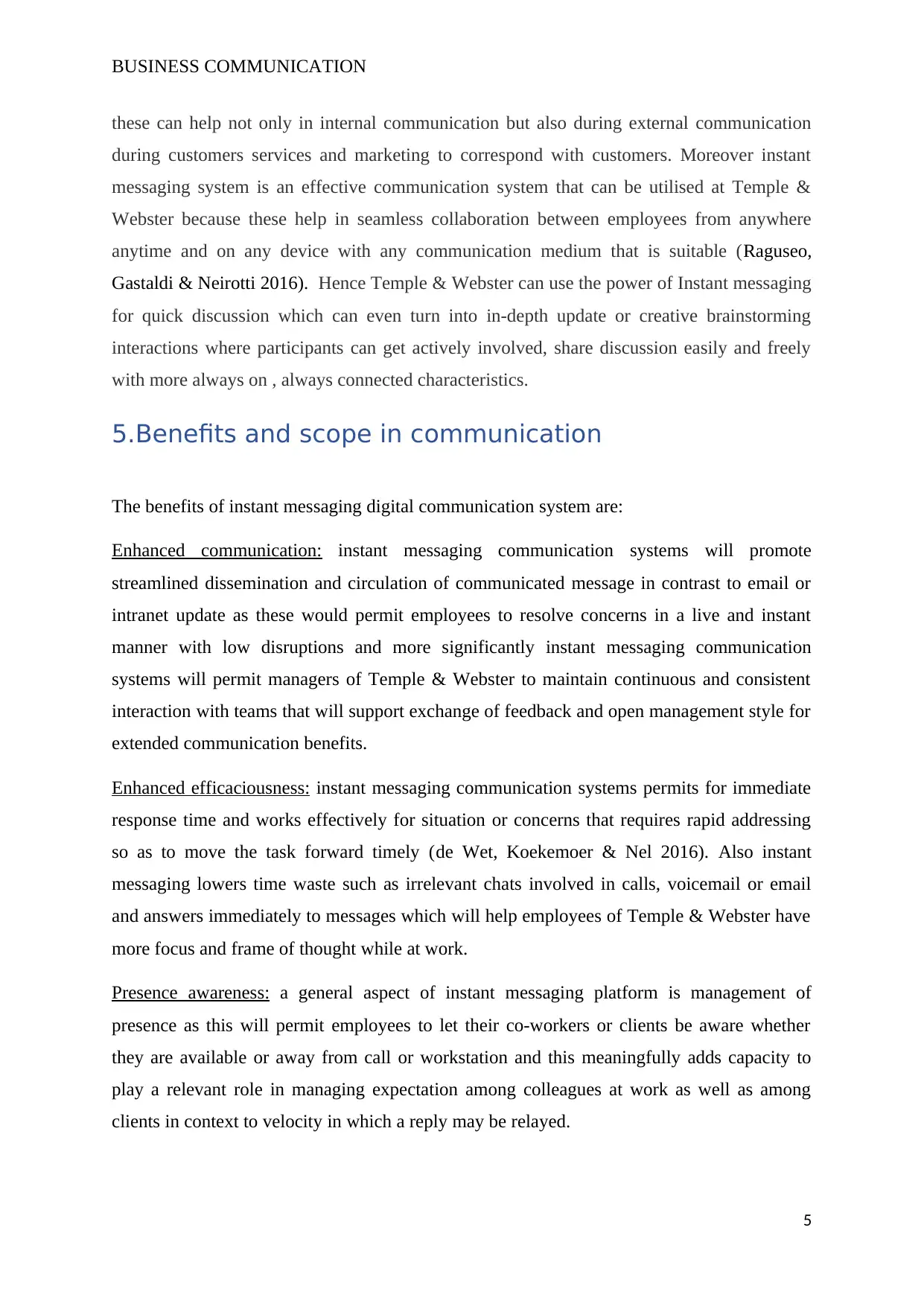
BUSINESS COMMUNICATION
these can help not only in internal communication but also during external communication
during customers services and marketing to correspond with customers. Moreover instant
messaging system is an effective communication system that can be utilised at Temple &
Webster because these help in seamless collaboration between employees from anywhere
anytime and on any device with any communication medium that is suitable (Raguseo,
Gastaldi & Neirotti 2016). Hence Temple & Webster can use the power of Instant messaging
for quick discussion which can even turn into in-depth update or creative brainstorming
interactions where participants can get actively involved, share discussion easily and freely
with more always on , always connected characteristics.
5.Benefits and scope in communication
The benefits of instant messaging digital communication system are:
Enhanced communication: instant messaging communication systems will promote
streamlined dissemination and circulation of communicated message in contrast to email or
intranet update as these would permit employees to resolve concerns in a live and instant
manner with low disruptions and more significantly instant messaging communication
systems will permit managers of Temple & Webster to maintain continuous and consistent
interaction with teams that will support exchange of feedback and open management style for
extended communication benefits.
Enhanced efficaciousness: instant messaging communication systems permits for immediate
response time and works effectively for situation or concerns that requires rapid addressing
so as to move the task forward timely (de Wet, Koekemoer & Nel 2016). Also instant
messaging lowers time waste such as irrelevant chats involved in calls, voicemail or email
and answers immediately to messages which will help employees of Temple & Webster have
more focus and frame of thought while at work.
Presence awareness: a general aspect of instant messaging platform is management of
presence as this will permit employees to let their co-workers or clients be aware whether
they are available or away from call or workstation and this meaningfully adds capacity to
play a relevant role in managing expectation among colleagues at work as well as among
clients in context to velocity in which a reply may be relayed.
5
these can help not only in internal communication but also during external communication
during customers services and marketing to correspond with customers. Moreover instant
messaging system is an effective communication system that can be utilised at Temple &
Webster because these help in seamless collaboration between employees from anywhere
anytime and on any device with any communication medium that is suitable (Raguseo,
Gastaldi & Neirotti 2016). Hence Temple & Webster can use the power of Instant messaging
for quick discussion which can even turn into in-depth update or creative brainstorming
interactions where participants can get actively involved, share discussion easily and freely
with more always on , always connected characteristics.
5.Benefits and scope in communication
The benefits of instant messaging digital communication system are:
Enhanced communication: instant messaging communication systems will promote
streamlined dissemination and circulation of communicated message in contrast to email or
intranet update as these would permit employees to resolve concerns in a live and instant
manner with low disruptions and more significantly instant messaging communication
systems will permit managers of Temple & Webster to maintain continuous and consistent
interaction with teams that will support exchange of feedback and open management style for
extended communication benefits.
Enhanced efficaciousness: instant messaging communication systems permits for immediate
response time and works effectively for situation or concerns that requires rapid addressing
so as to move the task forward timely (de Wet, Koekemoer & Nel 2016). Also instant
messaging lowers time waste such as irrelevant chats involved in calls, voicemail or email
and answers immediately to messages which will help employees of Temple & Webster have
more focus and frame of thought while at work.
Presence awareness: a general aspect of instant messaging platform is management of
presence as this will permit employees to let their co-workers or clients be aware whether
they are available or away from call or workstation and this meaningfully adds capacity to
play a relevant role in managing expectation among colleagues at work as well as among
clients in context to velocity in which a reply may be relayed.
5
⊘ This is a preview!⊘
Do you want full access?
Subscribe today to unlock all pages.

Trusted by 1+ million students worldwide
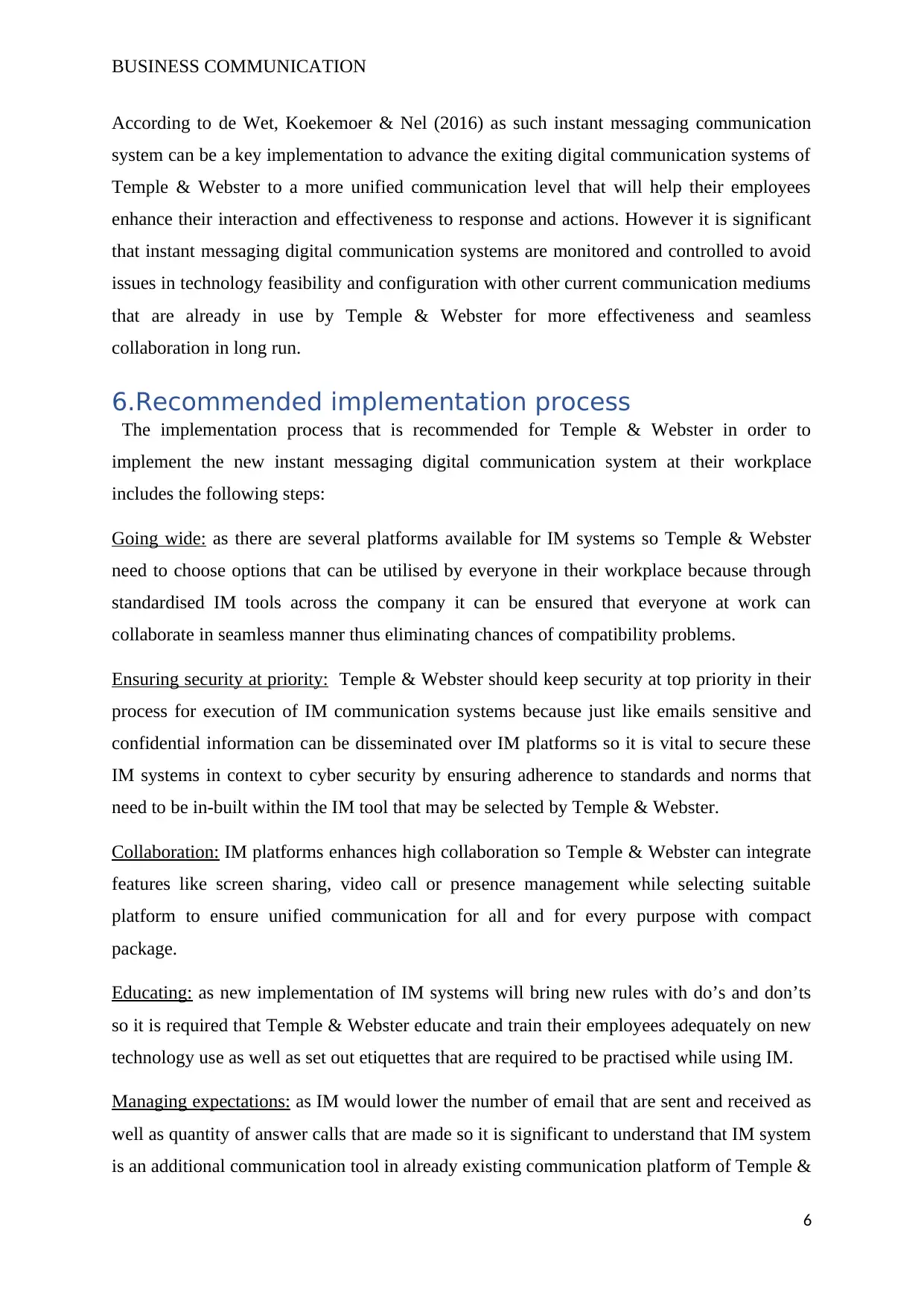
BUSINESS COMMUNICATION
According to de Wet, Koekemoer & Nel (2016) as such instant messaging communication
system can be a key implementation to advance the exiting digital communication systems of
Temple & Webster to a more unified communication level that will help their employees
enhance their interaction and effectiveness to response and actions. However it is significant
that instant messaging digital communication systems are monitored and controlled to avoid
issues in technology feasibility and configuration with other current communication mediums
that are already in use by Temple & Webster for more effectiveness and seamless
collaboration in long run.
6.Recommended implementation process
The implementation process that is recommended for Temple & Webster in order to
implement the new instant messaging digital communication system at their workplace
includes the following steps:
Going wide: as there are several platforms available for IM systems so Temple & Webster
need to choose options that can be utilised by everyone in their workplace because through
standardised IM tools across the company it can be ensured that everyone at work can
collaborate in seamless manner thus eliminating chances of compatibility problems.
Ensuring security at priority: Temple & Webster should keep security at top priority in their
process for execution of IM communication systems because just like emails sensitive and
confidential information can be disseminated over IM platforms so it is vital to secure these
IM systems in context to cyber security by ensuring adherence to standards and norms that
need to be in-built within the IM tool that may be selected by Temple & Webster.
Collaboration: IM platforms enhances high collaboration so Temple & Webster can integrate
features like screen sharing, video call or presence management while selecting suitable
platform to ensure unified communication for all and for every purpose with compact
package.
Educating: as new implementation of IM systems will bring new rules with do’s and don’ts
so it is required that Temple & Webster educate and train their employees adequately on new
technology use as well as set out etiquettes that are required to be practised while using IM.
Managing expectations: as IM would lower the number of email that are sent and received as
well as quantity of answer calls that are made so it is significant to understand that IM system
is an additional communication tool in already existing communication platform of Temple &
6
According to de Wet, Koekemoer & Nel (2016) as such instant messaging communication
system can be a key implementation to advance the exiting digital communication systems of
Temple & Webster to a more unified communication level that will help their employees
enhance their interaction and effectiveness to response and actions. However it is significant
that instant messaging digital communication systems are monitored and controlled to avoid
issues in technology feasibility and configuration with other current communication mediums
that are already in use by Temple & Webster for more effectiveness and seamless
collaboration in long run.
6.Recommended implementation process
The implementation process that is recommended for Temple & Webster in order to
implement the new instant messaging digital communication system at their workplace
includes the following steps:
Going wide: as there are several platforms available for IM systems so Temple & Webster
need to choose options that can be utilised by everyone in their workplace because through
standardised IM tools across the company it can be ensured that everyone at work can
collaborate in seamless manner thus eliminating chances of compatibility problems.
Ensuring security at priority: Temple & Webster should keep security at top priority in their
process for execution of IM communication systems because just like emails sensitive and
confidential information can be disseminated over IM platforms so it is vital to secure these
IM systems in context to cyber security by ensuring adherence to standards and norms that
need to be in-built within the IM tool that may be selected by Temple & Webster.
Collaboration: IM platforms enhances high collaboration so Temple & Webster can integrate
features like screen sharing, video call or presence management while selecting suitable
platform to ensure unified communication for all and for every purpose with compact
package.
Educating: as new implementation of IM systems will bring new rules with do’s and don’ts
so it is required that Temple & Webster educate and train their employees adequately on new
technology use as well as set out etiquettes that are required to be practised while using IM.
Managing expectations: as IM would lower the number of email that are sent and received as
well as quantity of answer calls that are made so it is significant to understand that IM system
is an additional communication tool in already existing communication platform of Temple &
6
Paraphrase This Document
Need a fresh take? Get an instant paraphrase of this document with our AI Paraphraser
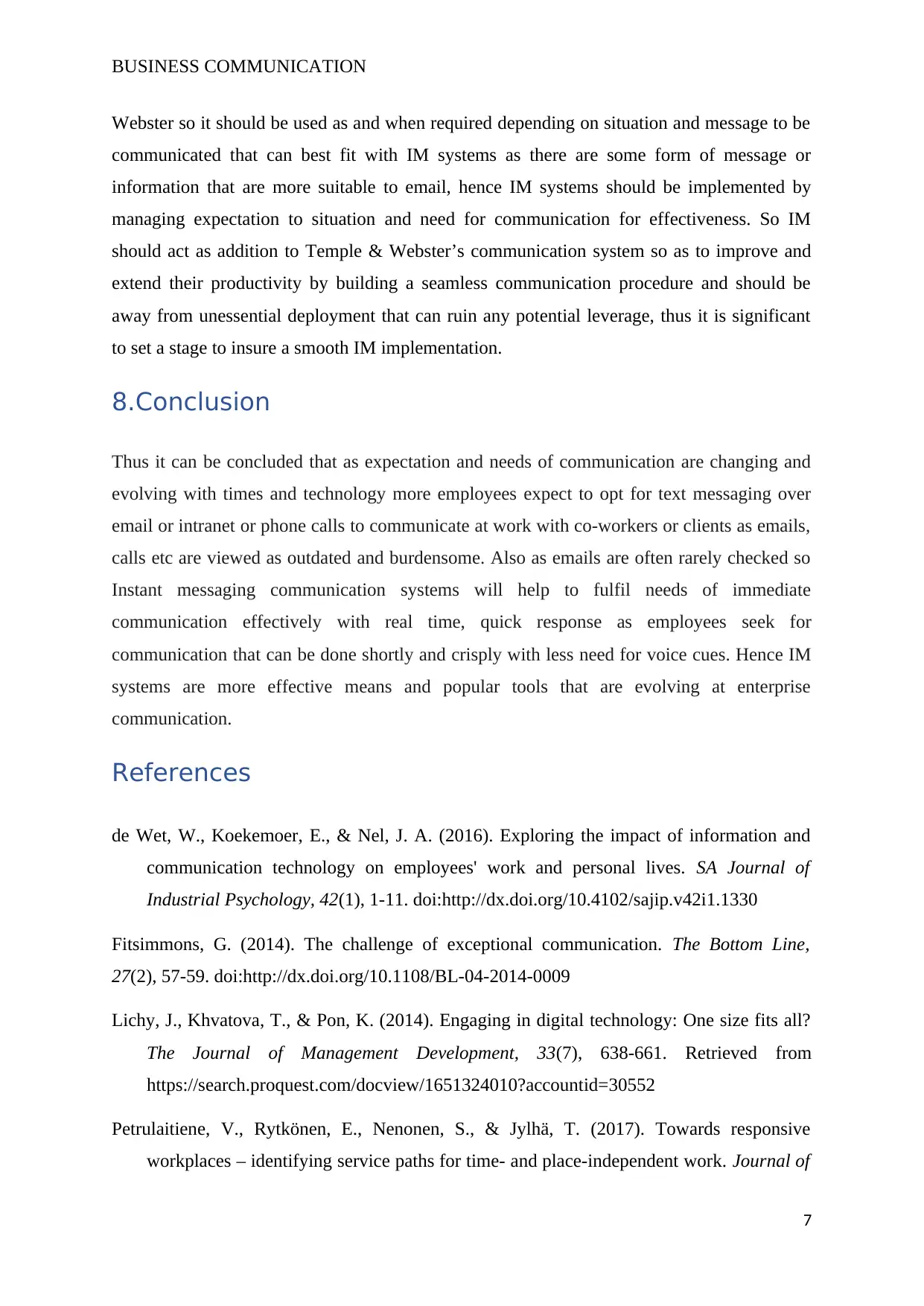
BUSINESS COMMUNICATION
Webster so it should be used as and when required depending on situation and message to be
communicated that can best fit with IM systems as there are some form of message or
information that are more suitable to email, hence IM systems should be implemented by
managing expectation to situation and need for communication for effectiveness. So IM
should act as addition to Temple & Webster’s communication system so as to improve and
extend their productivity by building a seamless communication procedure and should be
away from unessential deployment that can ruin any potential leverage, thus it is significant
to set a stage to insure a smooth IM implementation.
8.Conclusion
Thus it can be concluded that as expectation and needs of communication are changing and
evolving with times and technology more employees expect to opt for text messaging over
email or intranet or phone calls to communicate at work with co-workers or clients as emails,
calls etc are viewed as outdated and burdensome. Also as emails are often rarely checked so
Instant messaging communication systems will help to fulfil needs of immediate
communication effectively with real time, quick response as employees seek for
communication that can be done shortly and crisply with less need for voice cues. Hence IM
systems are more effective means and popular tools that are evolving at enterprise
communication.
References
de Wet, W., Koekemoer, E., & Nel, J. A. (2016). Exploring the impact of information and
communication technology on employees' work and personal lives. SA Journal of
Industrial Psychology, 42(1), 1-11. doi:http://dx.doi.org/10.4102/sajip.v42i1.1330
Fitsimmons, G. (2014). The challenge of exceptional communication. The Bottom Line,
27(2), 57-59. doi:http://dx.doi.org/10.1108/BL-04-2014-0009
Lichy, J., Khvatova, T., & Pon, K. (2014). Engaging in digital technology: One size fits all?
The Journal of Management Development, 33(7), 638-661. Retrieved from
https://search.proquest.com/docview/1651324010?accountid=30552
Petrulaitiene, V., Rytkönen, E., Nenonen, S., & Jylhä, T. (2017). Towards responsive
workplaces – identifying service paths for time- and place-independent work. Journal of
7
Webster so it should be used as and when required depending on situation and message to be
communicated that can best fit with IM systems as there are some form of message or
information that are more suitable to email, hence IM systems should be implemented by
managing expectation to situation and need for communication for effectiveness. So IM
should act as addition to Temple & Webster’s communication system so as to improve and
extend their productivity by building a seamless communication procedure and should be
away from unessential deployment that can ruin any potential leverage, thus it is significant
to set a stage to insure a smooth IM implementation.
8.Conclusion
Thus it can be concluded that as expectation and needs of communication are changing and
evolving with times and technology more employees expect to opt for text messaging over
email or intranet or phone calls to communicate at work with co-workers or clients as emails,
calls etc are viewed as outdated and burdensome. Also as emails are often rarely checked so
Instant messaging communication systems will help to fulfil needs of immediate
communication effectively with real time, quick response as employees seek for
communication that can be done shortly and crisply with less need for voice cues. Hence IM
systems are more effective means and popular tools that are evolving at enterprise
communication.
References
de Wet, W., Koekemoer, E., & Nel, J. A. (2016). Exploring the impact of information and
communication technology on employees' work and personal lives. SA Journal of
Industrial Psychology, 42(1), 1-11. doi:http://dx.doi.org/10.4102/sajip.v42i1.1330
Fitsimmons, G. (2014). The challenge of exceptional communication. The Bottom Line,
27(2), 57-59. doi:http://dx.doi.org/10.1108/BL-04-2014-0009
Lichy, J., Khvatova, T., & Pon, K. (2014). Engaging in digital technology: One size fits all?
The Journal of Management Development, 33(7), 638-661. Retrieved from
https://search.proquest.com/docview/1651324010?accountid=30552
Petrulaitiene, V., Rytkönen, E., Nenonen, S., & Jylhä, T. (2017). Towards responsive
workplaces – identifying service paths for time- and place-independent work. Journal of
7
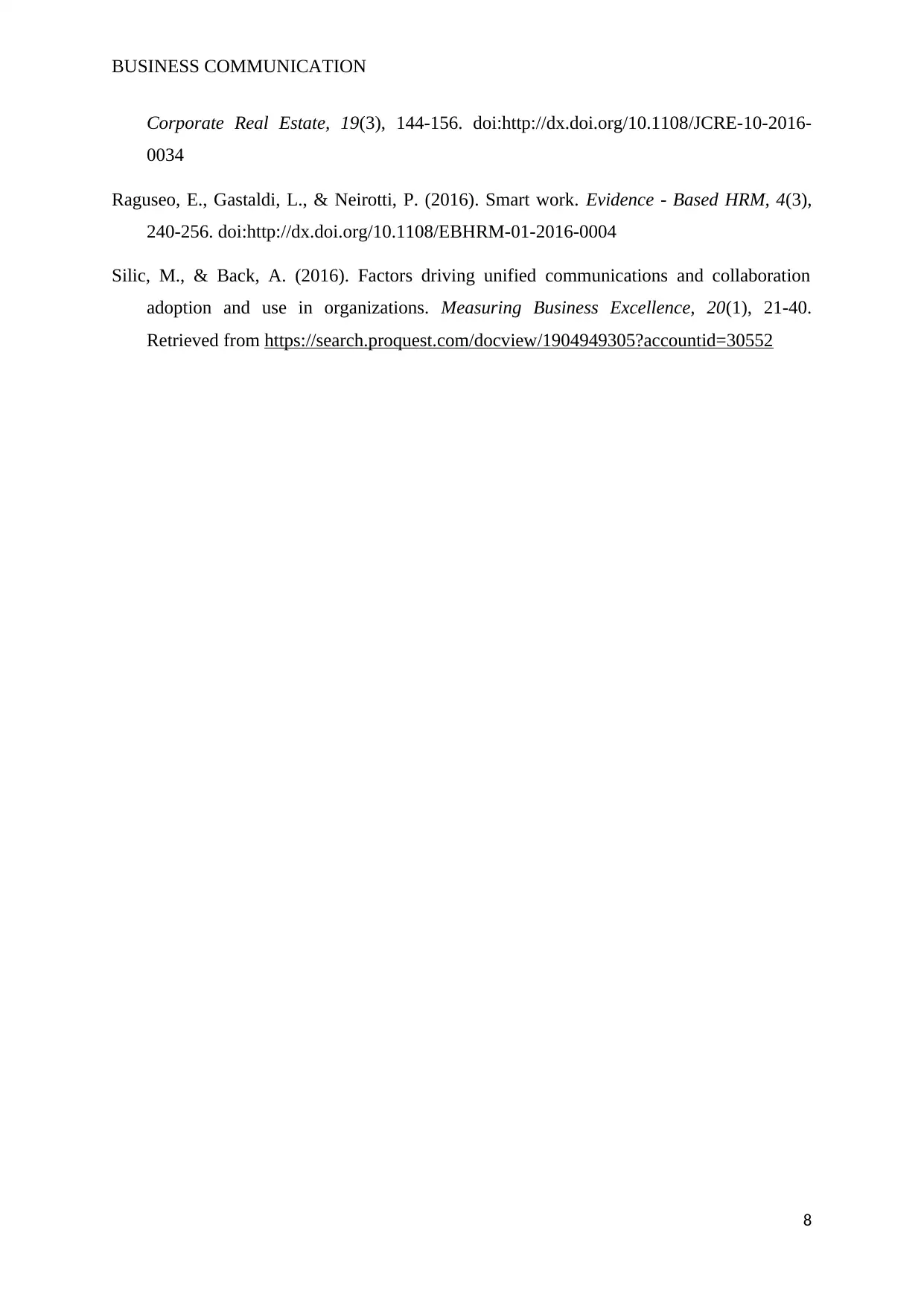
BUSINESS COMMUNICATION
Corporate Real Estate, 19(3), 144-156. doi:http://dx.doi.org/10.1108/JCRE-10-2016-
0034
Raguseo, E., Gastaldi, L., & Neirotti, P. (2016). Smart work. Evidence - Based HRM, 4(3),
240-256. doi:http://dx.doi.org/10.1108/EBHRM-01-2016-0004
Silic, M., & Back, A. (2016). Factors driving unified communications and collaboration
adoption and use in organizations. Measuring Business Excellence, 20(1), 21-40.
Retrieved from https://search.proquest.com/docview/1904949305?accountid=30552
8
Corporate Real Estate, 19(3), 144-156. doi:http://dx.doi.org/10.1108/JCRE-10-2016-
0034
Raguseo, E., Gastaldi, L., & Neirotti, P. (2016). Smart work. Evidence - Based HRM, 4(3),
240-256. doi:http://dx.doi.org/10.1108/EBHRM-01-2016-0004
Silic, M., & Back, A. (2016). Factors driving unified communications and collaboration
adoption and use in organizations. Measuring Business Excellence, 20(1), 21-40.
Retrieved from https://search.proquest.com/docview/1904949305?accountid=30552
8
⊘ This is a preview!⊘
Do you want full access?
Subscribe today to unlock all pages.

Trusted by 1+ million students worldwide
1 out of 9
Related Documents
Your All-in-One AI-Powered Toolkit for Academic Success.
+13062052269
info@desklib.com
Available 24*7 on WhatsApp / Email
![[object Object]](/_next/static/media/star-bottom.7253800d.svg)
Unlock your academic potential
Copyright © 2020–2025 A2Z Services. All Rights Reserved. Developed and managed by ZUCOL.




